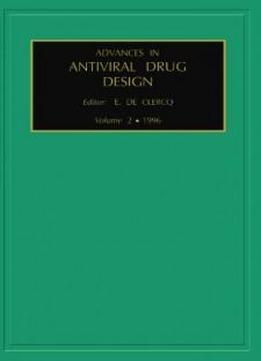
Advances In Antiviral Drug Design, Volume 2
by E. De Clercq /
1996 / English / PDF
6.3 MB Download
The purpose of the series on Advances in Antiviral Drug Design is
to regularly review the "state of the art" on emerging new
developments in the antiviral drug research field, thereby spanning
the conceptual design and chemical synthesis of new antiviral
compounds, their structure-activity relationship, mechanism and
target(s) of action, pharmacological behavior, antiviral activity
spectrum, and therapeutic potential for clinical use. Volume 2
begins with a description of the antiviral potential of antisense
oligonucleotides by J. Temsamani and S. Agrawal. According to the
aims of the anitsense technology, these oligonucleotides should be
targeted at specific viral antisense technology, these
oligonucleotides should be targeted at specific viral mRNA
sequences so that translation to the virus-specified proteins is
blocked; this has been achieved for a number of oligomers, some of
which are now in clinical trials for the treatment of HIV, HCMV,
and human papilloma virus (HPV) infections. Then C-S. Yuan, S. Liu,
S.F. Wnuk, M.J. Robins and R.T. Borchardt assess the role of
S-adenosylhornocysteine (AdoHcy) hydrolase as target for the design
of antiviral agents with broad-spectrum antiviral activity. This is
followed by an in-depth account on the design and synthesis of a
number of first-, second- and third-generation AdoHcy hydrolase
inhibitors and their mode of action at the enzyme level. V.E.
Marquez provides a comprehensive description of the various
carbocyclic (carba) nucleosides that have been synthesized and
evaluated for antiviral activity. Although the number and diversity
of the carba-nucleosides that have been found to be antivirally
active (or inactive) is astonishingly high, there is no limit to
further expansion of this fascinating class of molecules. For the
various nucleoside analogues that have to be intracellularly
phosphorylated to the 5'-triphosphate stage, to interact with th
The purpose of the series on Advances in Antiviral Drug Design is
to regularly review the "state of the art" on emerging new
developments in the antiviral drug research field, thereby spanning
the conceptual design and chemical synthesis of new antiviral
compounds, their structure-activity relationship, mechanism and
target(s) of action, pharmacological behavior, antiviral activity
spectrum, and therapeutic potential for clinical use. Volume 2
begins with a description of the antiviral potential of antisense
oligonucleotides by J. Temsamani and S. Agrawal. According to the
aims of the anitsense technology, these oligonucleotides should be
targeted at specific viral antisense technology, these
oligonucleotides should be targeted at specific viral mRNA
sequences so that translation to the virus-specified proteins is
blocked; this has been achieved for a number of oligomers, some of
which are now in clinical trials for the treatment of HIV, HCMV,
and human papilloma virus (HPV) infections. Then C-S. Yuan, S. Liu,
S.F. Wnuk, M.J. Robins and R.T. Borchardt assess the role of
S-adenosylhornocysteine (AdoHcy) hydrolase as target for the design
of antiviral agents with broad-spectrum antiviral activity. This is
followed by an in-depth account on the design and synthesis of a
number of first-, second- and third-generation AdoHcy hydrolase
inhibitors and their mode of action at the enzyme level. V.E.
Marquez provides a comprehensive description of the various
carbocyclic (carba) nucleosides that have been synthesized and
evaluated for antiviral activity. Although the number and diversity
of the carba-nucleosides that have been found to be antivirally
active (or inactive) is astonishingly high, there is no limit to
further expansion of this fascinating class of molecules. For the
various nucleoside analogues that have to be intracellularly
phosphorylated to the 5'-triphosphate stage, to interact with th











